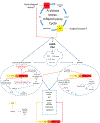Perioperative biobehavioral interventions to prevent cancer recurrence through combined inhibition of β-adrenergic and cyclooxygenase 2 signaling
- PMID: 30291805
- PMCID: PMC9385469
- DOI: 10.1002/cncr.31594
Perioperative biobehavioral interventions to prevent cancer recurrence through combined inhibition of β-adrenergic and cyclooxygenase 2 signaling
Abstract
Evidence suggests that excess perioperative activation of the sympathetic nervous system and the consequent release of catecholamines (ie, epinephrine and norepinephrine) in the context of cancer surgery and inflammation may significantly facilitate prometastatic processes. This review first presents biomedical processes that make the perioperative timeframe pivotal in determining long-term cancer outcomes nonproportionally to its short duration (days to weeks). Then, it analyzes the various mechanisms via which the excess release of catecholamines can facilitate the progression of cancer metastases in this context by directly affecting the malignant tissues and by regulating, via indirect pathways, immunological and other mechanisms that affect metastatic progression in the tumor microenvironment and systemically. In addition, this review addresses the need to supplement β-adrenoreceptor blockade with cyclooxygenase 2 inhibition, especially during surgery and shortly thereafter, because similar mechanisms are simultaneously activated by surgery-induced inflammatory responses. Importantly, this review presents translational and clinical evidence showing that perioperative β-adrenoreceptor blockade and cyclooxygenase 2 inhibition can reduce the prometastatic process and cancer recurrence, and the clinical feasibility and safety of this approach are demonstrated as well. Lastly, alternative psychophysiological approaches to the use of β-adrenergic blockers are presented because a substantial portion of patients have medical contraindications to this pharmacological treatment. The adaptation of existing psychophysiological interventions to the perioperative period and principles for constructing new approaches are discussed and exemplified. Overall, pharmacobehavioral interventions, separately or in combination, could transform the perioperative timeframe from being a prominent facilitator of metastatic progression to an opportunity for arresting or eliminating residual disease, potentially improving long-term survival rates in cancer patients.
Keywords: adrenergic; cancer; cyclooxygenase 2 (COX2) inhibitor; metastases; perioperative; psychophysiological; psychosocial; stress response; surgery; β-blocker.
© 2018 American Cancer Society.
Conflict of interest statement
Figures

References
-
- Ferlay J, Soerjomataram I, Dikshit R, et al. Cancer incidence and mortality worldwide: sources, methods and major patterns in GLOBOCAN 2012. International journal of cancer 2015;136(5). - PubMed
-
- Organizatoin WH. Cancer, Key facts 2017; http://www.who.int/mediacentre/factsheets/fs297/en/. Accessed 12/15/2017, 2017.
-
- (ONS) Oons. Population Estimates for UK, England and Wales, Scotland and Northern Ireland 2017; https://www.ons.gov.uk/peoplepopulationandcommunity/populationandmigrati.... Accessed 15/12/2017.
-
- U.S. Census Bureau PD. Annual Estimates of the Resident Population for Incorporated Places of 50,000 or More 2017; https://factfinder.census.gov/faces/tableservices/jsf/pages/productview.....Accessed 15/12/2017.
-
- Wikipedia. List of U.S. states and territories by population. 2017.
Publication types
MeSH terms
Substances
Grants and funding
LinkOut - more resources
Full Text Sources
Research Materials

